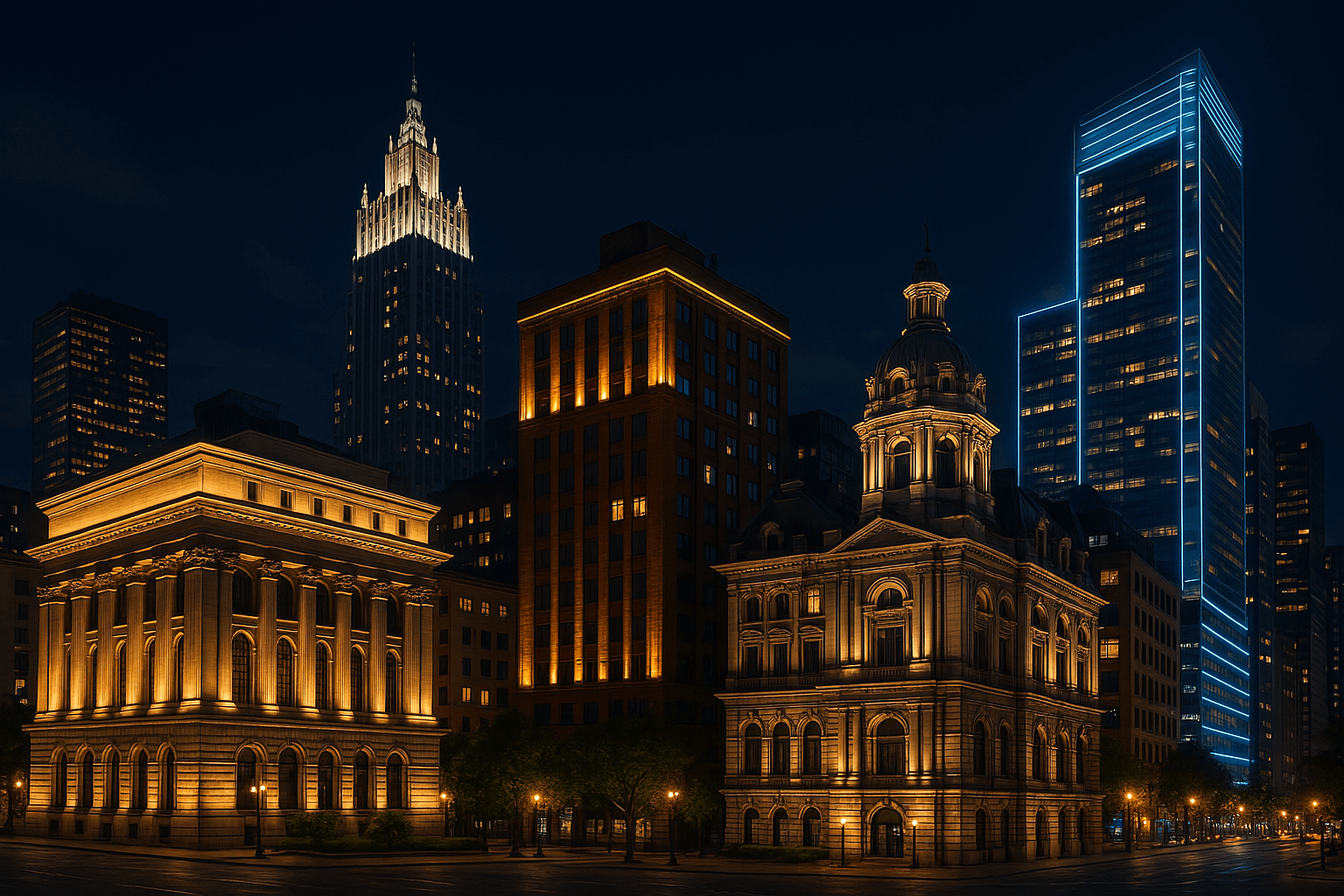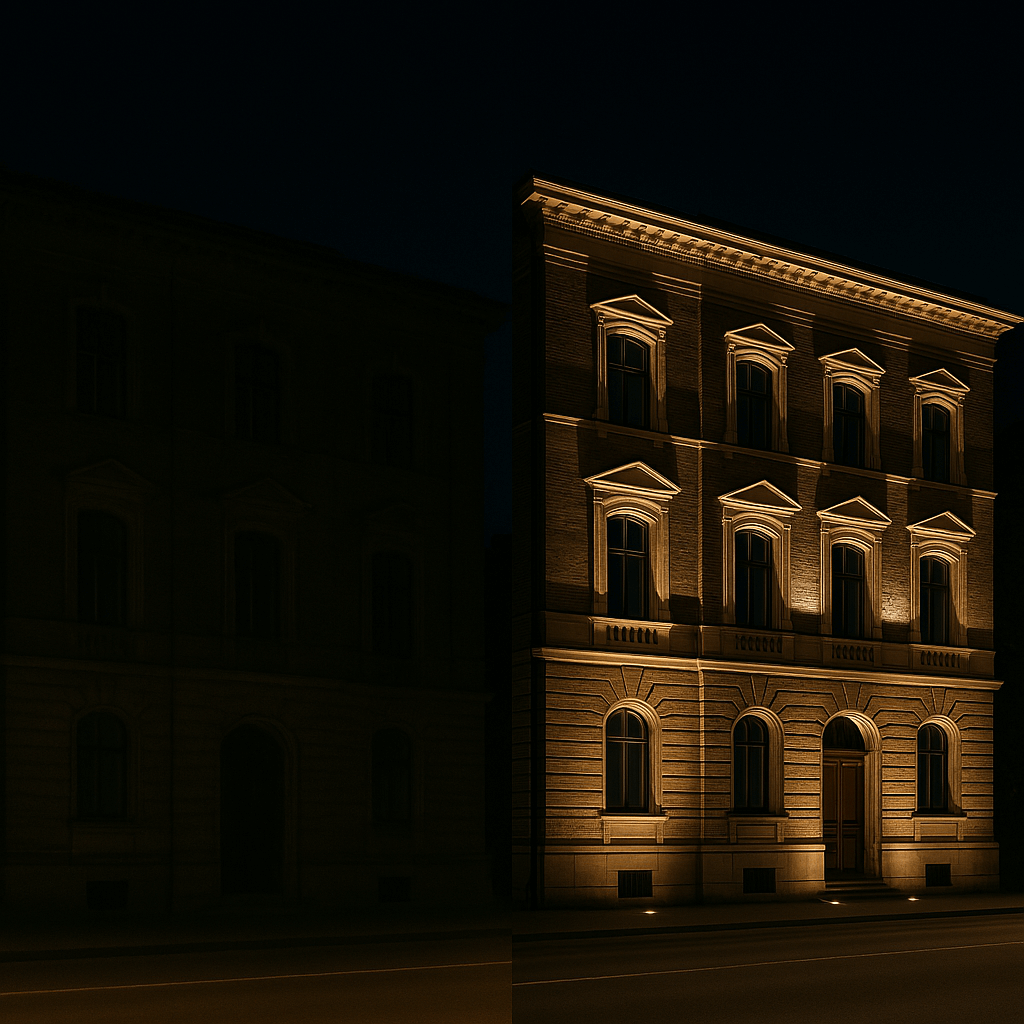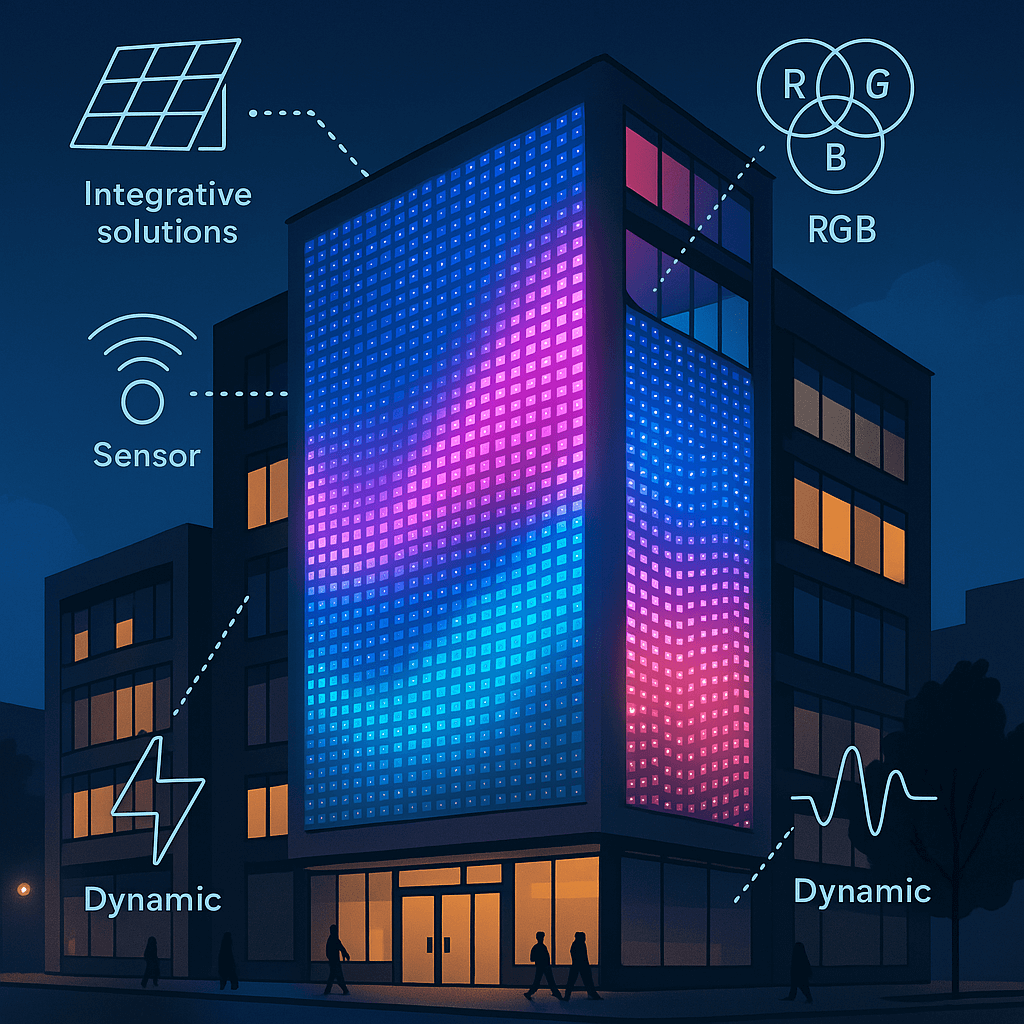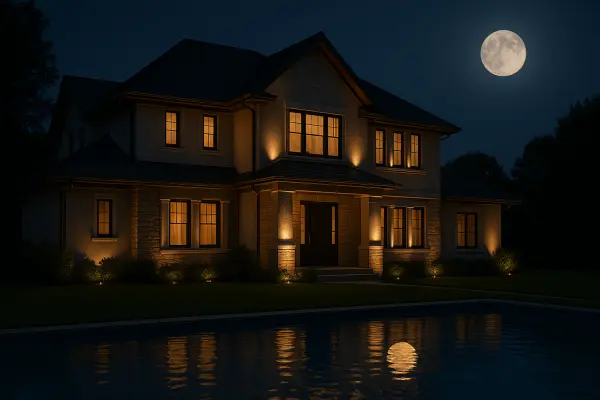In the modern world, architectural facade lighting is becoming an integral part of urban design, transforming buildings not just into functional structures, but into works of art. Facade illumination of buildings emphasizes the beauty and uniqueness of architectural forms, making urban spaces more attractive and vibrant. In this article, we will examine how facade lighting design transforms ordinary buildings into visually appealing objects, and explore various techniques and approaches to exterior building illumination used by contemporary designers and architects.
The Significance of Lighting in Architecture
Accentuating architectural elements with decorative facade illumination plays a key role and often serves as the "face" of the building. Artistic illumination of buildings highlights the unique features of structures, creating impressive visual effects unattainable solely with daylight. Well-designed facade lighting can completely transform the perception of architecture at night.

"Facade lighting is not just a technical solution, but an artistic tool that can breathe new life into any building. Properly designed facade lighting can reveal the architectural idea and emphasize the individuality of a structure even better than daylight does."
Richard Kelly, pioneer of architectural lighting
Techniques and Trends in Structural Lighting Aesthetics
In the world of architectural lighting design, both classical techniques and modern facade lighting technologies are used, including LED systems with dynamic color control, media facades, contour lighting, and even interactive water light screens. Buildings adorned with masterfully executed night illumination become true magnets for admiring glances and transform into bright dominants of the urban landscape. Skillfully developed exterior building lighting can instantly transform the perception of the entire building, creating an indelible impression and emotional connection with observers.
Professional facade lighting design is based on principles of architectural lighting that balance between science and art, taking into account both technical requirements and aesthetic components. This allows not only highlighting structural details with light but also creating a unique identity for the building that distinguishes it among urban development.
Types of Architectural Lighting
When designing building lighting, it is necessary to choose optimal types of facade lighting depending on the architectural style and purpose of the building.
| Type of Lighting | Characteristics | Application | Technologies |
|---|---|---|---|
| Contour Lighting | Emphasizes the silhouette of the building | High-rise buildings, shopping centers | LED neon, flexible LED strips |
| Flood Lighting | Evenly illuminates large surfaces | Historical buildings, architectural monuments | Floodlights, LED panels |
| Accent Lighting | Highlights individual architectural elements | Decorative elements, columns, bas-reliefs | Spotlights, narrow-beam projectors |
| Dynamic Lighting | Changes color and intensity over time | Entertainment complexes, modern business centers | RGB LEDs, programmable controllers |
| Media Facades | Transforms the facade into a screen | Shopping centers, hotels, public buildings | LED modules, video management systems |

Various facade lighting technologies allow creating unique lighting solutions for buildings of any complexity and style. Energy-efficient facade lighting is becoming an increasingly important factor in the design of modern facilities.
Using 3D lighting visualization, unique facade lighting compositions are created, giving buildings individuality and turning them into famous landmarks. Modern sensors and controllers allow lighting systems to adapt to external conditions, providing ideal exterior lighting of structures in any weather.
Variety of Approaches to Building Lighting Design
Modern facade lighting technologies enable the creation of unique lighting solutions for both commercial and private properties. Private home illumination is becoming increasingly popular among homeowners who wish to emphasize the architectural features of their dwellings. Each type of building requires an individual approach — shopping center lighting differs significantly from the illumination of historical buildings or high-rise building lighting.
An important factor in design is the color temperature for facades, which can range from warm yellow (2700K) to cool white (6500K). The choice of temperature depends on the facade material, architectural style, and overall lighting concept. Artistic building illumination often includes colored architectural lighting, which becomes especially relevant for facade illumination during holidays and special events.
BIM lighting design is increasingly being used by professional lighting designers, allowing them to model lighting effects before installation work begins. Facade lighting companies offer not only turnkey facade lighting installation but also related services: maintenance of facade lighting systems and repair and replacement of facade lights.
Light as a Project Visualization Tool
Working with light is a way to demonstrate the concept of your facade lighting project. Combining architectural lighting design with the structural features of a building can lead to unexpected and impressive results. When designing facade lighting, it's important to remember numerous nuances, including external light sources and light reflection from various surfaces.
"When creating a lighting scenario for a building, it is necessary to consider not only aesthetic aspects but also functionality, energy efficiency, and environmental impact. Well-designed lighting should emphasize architecture without competing with it."
Roger Narboni, lighting designer
Integration of Natural Light
The trend towards using natural light means that when developing lighting for architectural details, both open and closed spaces should be considered, as well as the transition between daylight and artificial lighting. It is especially important to correctly calculate the power of facade lighting to create a harmonious light environment.
Facade Lighting as an Art Form
Decorative facade illumination can transform into true art. An example of this is the Louvre in Abu Dhabi, which showcases traditional Arabic design with a dome-shaped roof. Innovative light filters accentuate the beauty of the building and provide protection for valuable exhibits inside.
Success Story: Light Transformation of a Historic Building
 In 2019, a team of facade lighting specialists undertook the project of illuminating a 19th-century historic mansion in the center of a European capital. The building had long remained inconspicuous at night, lost among more modern and brightly lit structures. The project included the development of delicate LED lighting that would emphasize architectural details without disturbing the historic appearance of the building. Thanks to the use of fixtures with a color temperature that imitated the soft light of candles, and precise accent lighting on decorative elements, the facade literally came alive during dark hours. After the project's completion, the visitation of the museum located in the building increased by 40% in the evening hours, and the building itself became a popular attraction for evening photo sessions and tours.
In 2019, a team of facade lighting specialists undertook the project of illuminating a 19th-century historic mansion in the center of a European capital. The building had long remained inconspicuous at night, lost among more modern and brightly lit structures. The project included the development of delicate LED lighting that would emphasize architectural details without disturbing the historic appearance of the building. Thanks to the use of fixtures with a color temperature that imitated the soft light of candles, and precise accent lighting on decorative elements, the facade literally came alive during dark hours. After the project's completion, the visitation of the museum located in the building increased by 40% in the evening hours, and the building itself became a popular attraction for evening photo sessions and tours.
The work on the Louvre in Abu Dhabi is an example of successful collaboration between professionals from different fields to achieve incredible lighting effects. This project demonstrates how LED technologies in architecture can unlock the potential of modern buildings.
The Importance of Natural Light
When developing architectural lighting design, the importance of natural light in complex conditions is taken into account. Such an approach at the Louvre in Abu Dhabi allowed the creation of one of the most iconic buildings of our time, demonstrating a unique combination of artistic mastery and technological innovation in the field of architectural monument illumination.
"Light is not just a tool for ensuring visibility; it is the most important element of architectural composition. The impact of light on the perception of architecture is colossal: it can visually change proportions, reveal or hide details, create mood and emotional atmosphere around the building."
Jean Nouvel, architect of the Louvre in Abu Dhabi
Environmental Aspects of Facade Lighting
The environmental factor is becoming increasingly important in the design of architectural facade lighting. Light pollution is a serious problem in modern cities, affecting human biorhythms, bird migration, and insect life cycles. According to a study by the International Dark-Sky Association (IDA), uncontrolled lighting of urban areas annually leads to the death of millions of migratory birds and disrupts natural ecosystems.
Modern approaches to facade lighting include solutions such as:
- Directed fixtures that minimize light scattering into the sky
- Systems with motion sensors that activate lighting only when necessary
- Use of warm spectrum to reduce impact on biorhythms
- Programmable dimming or switching off at certain hours
Energy-efficient facade lighting not only reduces operational costs but also significantly lowers the building's carbon footprint. According to statistics, the transition to modern LED systems with intelligent control can reduce lighting energy consumption by up to 80% compared to traditional technologies.
Technical Aspects of Facade Lighting
Modern trends in facade lighting are associated with the development of technologies and the emergence of new materials. When installing architectural lighting, it is important to consider not only aesthetic but also practical aspects.
LED Facade Lighting
LED solutions for buildings have gained the greatest popularity in modern architectural lighting design due to their energy efficiency, long service life of LED lighting (up to 50,000-100,000 hours), and wide control capabilities. Methods of installing facade lighting depend on the building type and desired effect. When choosing equipment for architectural lighting, it is important to consider not only cost but also quality, reliability, and energy efficiency.
Modern smart lighting technologies, initially developed for interiors, are increasingly being applied in facade lighting, allowing the creation of stunning lighting scenarios for buildings that instantly attract attention and remain in memory for a long time. Building owners who have invested in quality facade lighting note a significant increase in the prestige of their property and growing interest from clients and partners. The price of LED facade lighting, which can vary depending on the complexity of the project, is usually recouped through reduced energy consumption and minimal maintenance costs.
Lighting control automation allows for setting up different illumination scenarios depending on the time of day, season, or events being held. Such systems are especially in demand for facade lighting in different styles – from classic to ultra-modern high-tech.
Innovations and Trends in Facade Lighting 2025
 Modern architectural lighting design is rapidly evolving thanks to technological breakthroughs. Let's look at the key trends that define the future of architectural illumination:
Modern architectural lighting design is rapidly evolving thanks to technological breakthroughs. Let's look at the key trends that define the future of architectural illumination:
- Interactive Facades — lighting systems that respond to weather, time of day, or pedestrian activity. According to the Lighting Research Center, interactive facades increase the attractiveness of commercial properties by 35%.
- Micro-LED Technologies — a new generation of LEDs with improved color rendering and the ability to create ultra-thin light lines, opening revolutionary possibilities for design.
- Biodynamic Lighting — systems that imitate natural changes in daylight, which positively affects the psychological perception of architecture.
- Solar-Integrated Solutions — facade lights with their own solar panels, providing autonomy and environmental friendliness.
A study conducted by the American Association of Architects in 2024 showed that properties with innovative facade lighting attract 42% more visitors in the evening and increase the rental value of commercial premises by an average of 18%. These data confirm not only the aesthetic but also the economic efficiency of investments in modern building illumination systems.
Safety and Regulation in Facade Lighting
Facade lighting and safety are closely interconnected, as well-designed illumination not only decorates the building but also increases the security level of the surrounding area. When designing, it is necessary to consider the norms and standards for facade lighting that regulate maximum brightness, operating time, and other parameters to prevent light pollution and ensure residents' comfort.
Facade lighting installation services should be provided by qualified specialists with appropriate permits and authorizations. When operating these systems, it is important to provide for regular maintenance, including cleaning of fixtures, checking electrical connections, and, if necessary, timely repair of components.
In large cities and historical centers, there are special regulations that define the permissible types of illumination for various categories of buildings. These documents are developed taking into account architectural and cultural features and are aimed at creating a harmonious light environment in urban space.
Examples of Successful Facade Lighting
Among the most impressive examples of successful facade lighting are the Burj Khalifa tower in Dubai with its dynamic light shows, the Opera House in Sydney with spot lighting of the famous "sails," the Empire State Building in New York with programmable RGB lighting that changes colors depending on events and holidays. In Russia, prominent examples include the illumination of the Ostankino Tower, the Moscow City complex of buildings, and historical buildings with illumination on Red Square. Each of these projects demonstrates how lighting changes the appearance of the city and transforms architectural structures into iconic objects.
The Role of Light in Architecture
The role of light in architecture goes far beyond simple functional illumination. The lighting design of buildings forms a visual hierarchy of elements, emphasizes the texture of materials, creates mood and emotional response, and can visually transform the proportions of the structure. In the modern architectural approach, light is considered a full-fledged building material that is actively used to create artistic images. A properly designed lighting system can reveal the architect's concept and give the building a completely new interpretation during dark hours.
Conclusion
The art of building facade lighting continues to evolve, combining engineering solutions, architectural concepts, and artistic vision. Modern facade lighting technologies open new possibilities for creative expression for architects and lighting designers. Well-designed facade lighting not only emphasizes the beauty of buildings at night but also creates a special atmosphere in urban space, making it more attractive and safe.
From classical monumental buildings to modern high-rise structures, properly selected illumination can not only reveal the architectural concept but also create new aesthetic value. At the same time, factors of energy efficiency and environmental friendliness of lighting solutions are becoming increasingly important, allowing minimization of negative environmental impact.
Companies specializing in facade lighting installation services today offer comprehensive solutions that include not only design and installation but also subsequent maintenance of facade lighting systems. It is important to understand that quality implementation of such projects requires the participation of specialists from various fields: architects, engineers, lighting designers, and electricians capable of embodying a unified concept that takes into account both aesthetic and technical aspects.
Recommended Literature for In-Depth Study
- Ulrike Brandi, Christoph Geissmar-Brandi: "Light for Cities: Lighting Design for Urban Spaces"
- Malcolm Innes: "Lighting for Interior Design"
- Kaoru Mende: "Designing with Light and Shadow"
- Roger Narboni: "Lighting the Landscape: Art, Design, Technologies"
- Mark Major, Jonathan Speirs, Anthony Tischhauser: "Made of Light: The Art of Light and Architecture"
- Janet Turner: "Designing with Light: Public Places, Lighting Solutions for Exhibitions, Museums and Historic Spaces"
- Christopher Cuttle: "Light for Art's Sake: Lighting for Artworks and Museum Displays"
- William M.C. Lam: "Perception and Lighting as Formgivers for Architecture"
- Gary Steffy: "Architectural Lighting Design"
- Louis Clair: "Architectures de lumières"

